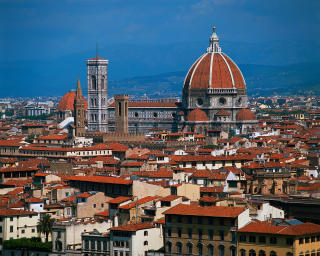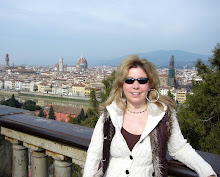

This opportunity dates back to an Association for Business Communication conference that I attended in San Antonio last October. During the conference I had the good fortune of meeting Gina Poncini, associate professor of the Faculty of Political Science at the University of Milan. A fast 15-minute conversation on one of our breaks, followed by several e-mail messages, resulted in a day that neither her students nor my students will ever forget. 
We all met at the Santa Maria Novella train station at 6:45, which felt even earlier for many of us! Our train left the station promptly at 7:08, bound for Milan.





Some students used the three-hour train ride to catch up on some work, as the Tuscan countryside rolled by.


Our train pulled into the Milano Centrale train station at about 10 a.m. We then had to learn how to navigate Milan's subway system, but the instructions Gina provided were extremely clear, so it was no problem. The only glitch was when we got on the first subway train, and the doors shut before six of our group could get on. Luckily I was able to shout out "Duomo" before the train left the station so that they knew what stop to get off on. The rest of us, of course, waited, waving our hands madly as their train approached.

Once we got to our final destination, I called Gina, and she sent three of her students over to meet us so that they could lead us back to the University of Milan campus. The University of Milan is one of the largest universities in Italy, with a student population of over 62,000. Founded in 1923, the University has nine faculties (schools), including the faculty we visited, the Faculty of Political Science (offical name: Facoltà di Scienze politiche dell’Università degli Studi di Milano).





This part of the university is housed in a gorgeous palazzo near the historic city center. Greeting us as we entered was a sign announcing our visit, and the classroom was already filled with Italian students. They gave a little time to freshen up, get coffee, change, and so on. And then the presentations began...
The Italian students, all in the European Economics Degree program, gave the first presentation, during which they educated us about their university and their degree program. We learned that attendance in Italian classes is optional; and rather than earning credits, Italian students must pass a certain number of tests. And here's what really surprised my students: most of the exams at Italian universities are oral, given by professors in front of large groups of people. Talk about pressure!


After the presentation, the two groups joined in the front of the classroom to answer questions. Up until this point, the group had been rather quiet, perhaps even uncomfortable with one another, that is until one of my students pulled a classif Freudian slip that helped to break the ice (I'll keep her nameless!). She meant to 

Next on the agenda was a presentation by the Italian students on student work in Italy, which is much different from in the United States. In the U.S. many students earn money by working retail or waiting tables, but in Italy store clerks and waiters are professional career positions. Therefore, there's very little for students to do to earn extra money. We learned that many tutor, work in pubs, or play music. One of the presenters even had his own band, which was exciting.

My students (Mohammed, Gillian, and Robert) then gave a presentation on getting a job in the U.S. The crowd was delighted by the slide show at the end, which showed photos of these three going through the job search and interview process. And look how professional they all look!

These next two groups then got together so that the audience could ask questions. We had no slips this time, but the Q&A session was entertaining just the same.


Next on the agenda: an American student presentation on sports and recreation in the Bay Area. This group (Madison, Karla, Jonathan, Paul, and Ben) covered it all: professional sports (football, baseball, basketball, and hockey) and recreational sports (hang gliding, mountain biking, skiing, and snowboarding). And perhaps the biggest hit with the Italian students was the section on surfing, given by our own avid surfer, Paul, complete with a picture of him with his first surfboard.


Because we had more presentation teams, an American team also gave the next presentation, this one on driving in the United States. A team of women (Karla, Brittany, Meaghan, and Gina), all dressed like a team in white shirts and black pants, gave this very interesting presentation. You see, the Italian students were surprised to learn that we are allowed to get our drivers licenses at age 16; they must wait until age 18. They also loved the slide showing a photo of a typical large SUV placed side-by-side with a typical Italian SmartCar. What a difference!


Next up, the final American presentation, this one covering the 1906 San Francisco Earthquake. I had actually talked this team (Vanessa, Kim, Lindsay, and Mallory) into selecting this topic; they knew nothing about it to begin with. But they did such phenomenal research that you would have sworn they were experts. Not only did they present interesting facts about the quake, fire, and recovery, but they brought in Italian connections. One was the fact that Enrico Caruso, the great Italian tenor, was actually in San Francisco at the time. He had appeared in Carmen at the San Francisco Opera House the night before the earthquake; and when the earthquake struck, he was asleep in his room in the legendary Palace Hotel, which still stands today. They also told the group about a group of Italians who managed to save several homes on Telegraph Hill by fighting the fire off with wine they had stored in their basements. Those home still stand today, some of the oldest structures in San Francisco.

The final presentation of the day was by a group of Italian students, giving ideas for things that our students could do while in Milan, including shopping and going to discos. They even prepared a handout with suggestions for different hot spots, something my students greatly appreciated.

After a huge round of applause for all of the presenters, we went out into the university's beautiful courtyard for a group shot. And then it was off to hit the streets of Milan...











No comments:
Post a Comment